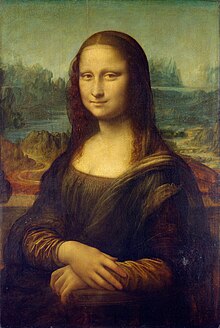
Back Skilderkuns Afrikaans Malerei ALS ስዕል Amharic Pintura AN رسم (فنون تشكيلية) Arabic رسيم (فن تشكيلي) ARY رسم ARZ চিত্ৰাঙ্কন Assamese Pintura AST Lingeropa AVK


Painting is a visual art, which is characterized by the practice of applying paint, pigment, color or other medium to a solid surface (called the "matrix"[1] or "support").[2] The medium is commonly applied to the base with a brush, but other implements, such as knives, sponges, and airbrushes, may be used. One who produces paintings is called a painter.
In art, the term "painting" describes both the act and the result of the action (the final work is called "a painting"). The support for paintings includes such surfaces as walls, paper, canvas, wood, glass, lacquer, pottery, leaf, copper and concrete, and the painting may incorporate multiple other materials, including sand, clay, paper, plaster, gold leaf, and even whole objects.
Painting is an important form of visual art, bringing in elements such as drawing, composition, gesture, narration, and abstraction.[3] Paintings can be naturalistic and representational (as in still life and landscape painting), photographic, abstract, narrative, symbolistic (as in Symbolist art), emotive (as in Expressionism) or political in nature (as in Artivism).
A portion of the history of painting in both Eastern and Western art is dominated by religious art. Examples of this kind of painting range from artwork depicting mythological figures on pottery, to Biblical scenes on the Sistine Chapel ceiling, to scenes from the life of Buddha (or other images of Eastern religious origin).
- ^ "What Is Printmaking?". The Metropolitan Museum of Art. Retrieved 3 August 2023.
- ^ "Paint – Definition". Merriam-webster.com. 2012. Archived from the original on 4 March 2018. Retrieved 13 March 2014.
- ^ Perry, Lincoln (Summer 2014). "The Music of Painting". The American Scholar. 83 (3): 85.